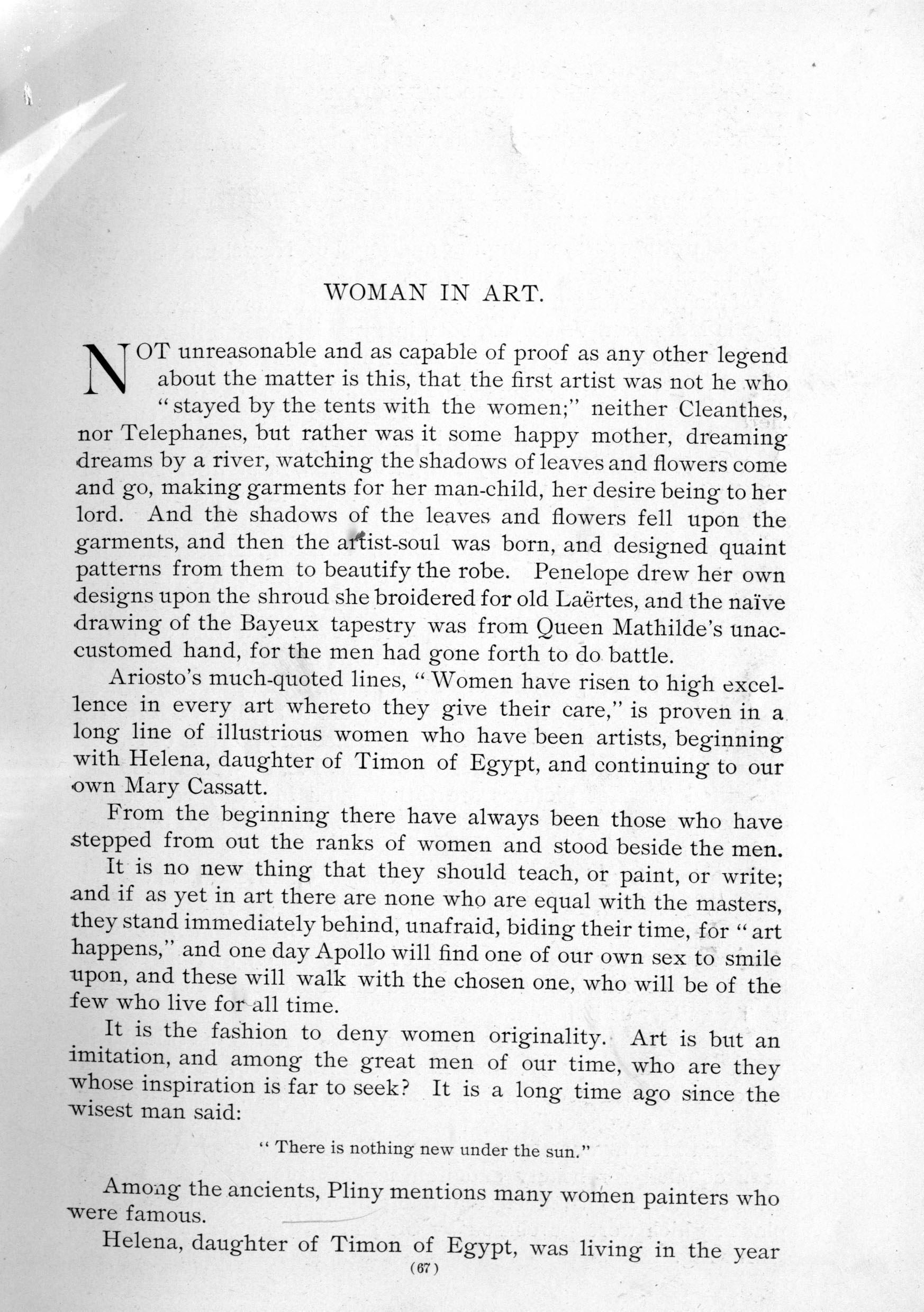
WOMAN IN ART.
NOT unreasonable and as capable of proof as any other legend about the matter is this, that the first artist was not he who "stayed by the tents with the women;" neither Cleanthes, nor Telephanes, but rather was it some happy mother, dreaming dreams by a river, watching the shadows of leaves and flowers come and go, making garments for her man child, her desire being to her lord. And the shadows of the leaves and flowers fell upon the garments, and then the artist-soul was born, and designed quaint patterns from them to beautify the robe. Penelope drew her own designs upon the shroud she broidered for old Laërtes, and the naïve drawing of the Bayeux tapestry was from Queen Mathilde's unaccustomed hand, for the men had gone forth to do battle.
Ariosto's much-quoted lines, "Women have risen to high excellence in every art whereto they give their care," is proven in a long line of illustrious women who have been artists, beginning with Helena, daughter of Timon of Egypt, and continuing to our own Mary Cassatt.
From the beginning there have always been those who have stepped from out the ranks of women and stood beside the men.
It is no new thing that they should teach, or paint, or write; and if as yet in art there are none who are equal with the masters, they stand immediately behind, unafraid, biding their time, for "art happens," and one day Apollo will find one of our own sex to smile upon, and these will walk with the chosen one, who will be of the few who live for all time.
It is the fashion to deny women originality. Art is but an imitation, and among the great men of our time, who are they whose inspiration is far to seek? It is a long time ago since the wisest man said:
"There is nothing new under the sun."
Among the ancients, Pliny mentions many women painters who were famous.
Helena, daughter of Timon of Egypt, was living in the year
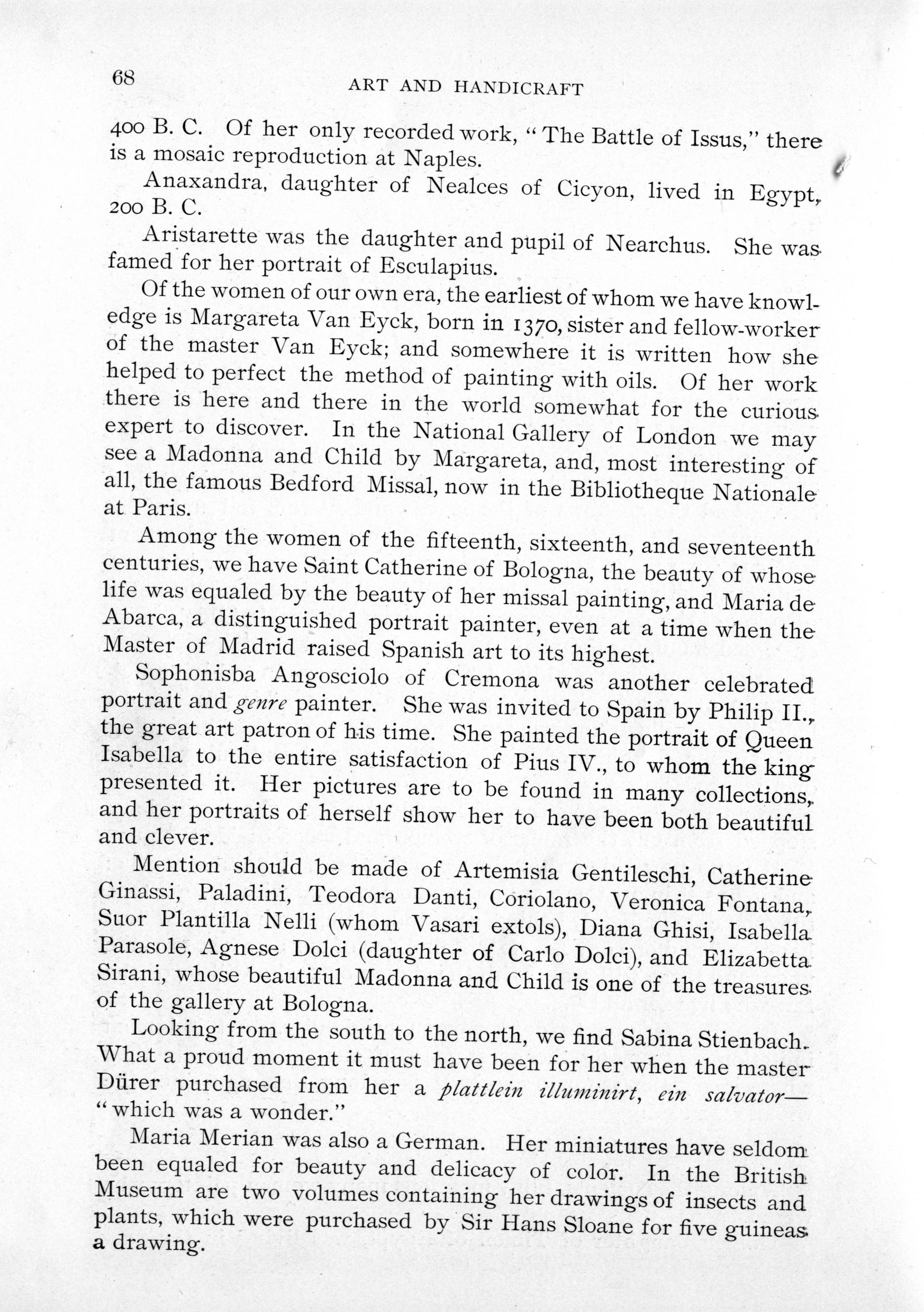
400 B. C. Of her only recorded work, "The Battle of Issus," there is a mosaic reproduction at Naples.
Anaxandra, daughter of Nealces of Cicyon, lived in Egypt, 200 B. C.
Aristarette was the daughter and pupil of Nearchus. She was famed for her portrait of Esculapius.
Of the women of our own era, the earliest of whom we have knowledge is Margareta Van Eyck, born in 1370, sister and fellow-worker of the master Van Eyck; and somewhere it is written how she helped to perfect the method of painting with oils. Of her work there is here and there in the world somewhat for the curious expert to discover. In the National Gallery of London we may see a Madonna and Child by Margareta, and, most interesting of all, the famous Bedford Missal, now in the Bibliotheque Nationale at Paris.
Among the women of the fifteenth, sixteenth, and seventeenth centuries, we have Saint Catherine of Bologna, the beauty of whose life was equaled by the beauty of her missal painting, and Maria de Abarca, a distinguished portrait painter, even at a time when the Master of Madrid raised Spanish art to its highest.
Sophonisba Angosciolo of Cremona was another celebrated portrait and genre painter. She was invited to Spain by Philip II., the great art patron of his time. She painted the portrait of Queen Isabella to the entire satisfaction of Pius IV., to whom the king presented it. Her pictures are to be found in many collections and her portraits of herself show her to have been both beautiful and clever.
Mention should be made of Artemisia Gentileschi, Catherine Ginassi, Paladini, Teodora Danti, Coriolano, Veronica Fontana, Suor Plantilla Nelli (whom Vasari extols), Diana Ghisi, Isabella Parasole, Agnese Dolci (daughter of Carlo Dolci), and Elizabetta Sirani, whose beautiful Madonna and Child is one of the treasures. of the gallery at Bologna.
Looking from the south to the north, we find Sabina Stienbach What a proud moment it must have been for her when the master Dürer purchased from her a plattlein illuminirt, ein salvator— "which was a wonder."
Maria Merian was also a German. Her miniatures have seldom been equaled for beauty and delicacy of color. In the British Museum are two volumes containing her drawings of insects and plants, which were purchased by Sir Hans Sloane for five guineas a drawing.
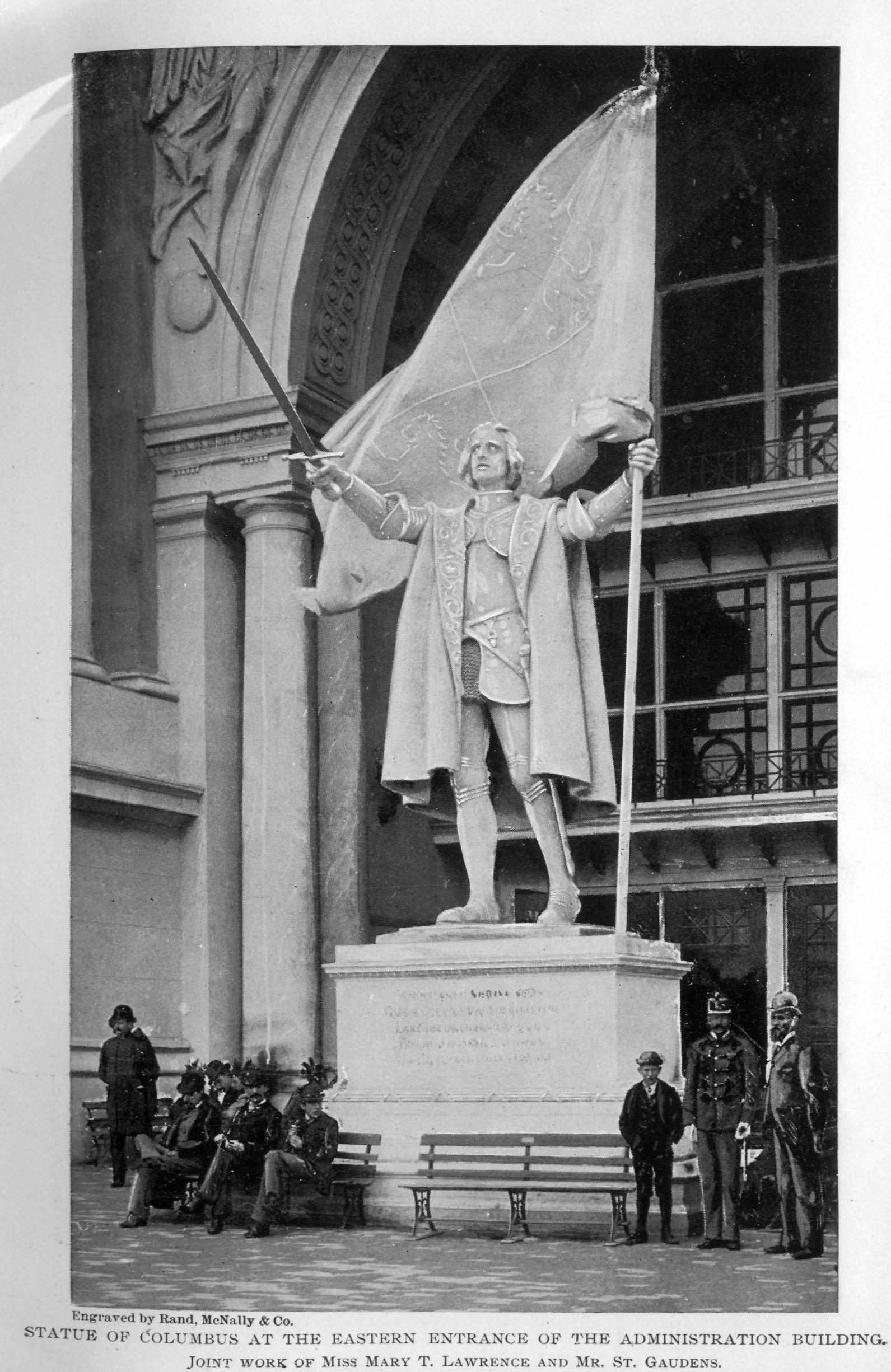
Engraved by Rand, McNally & Co.
STATUE OF COLUMBUS AT THE EASTERN ENTRANCE OF THE ADMINISTRATION BUILDING.
JOINT WORK OF MISS MARY T. LAWRENCE AND MR. ST. GAUDENS.
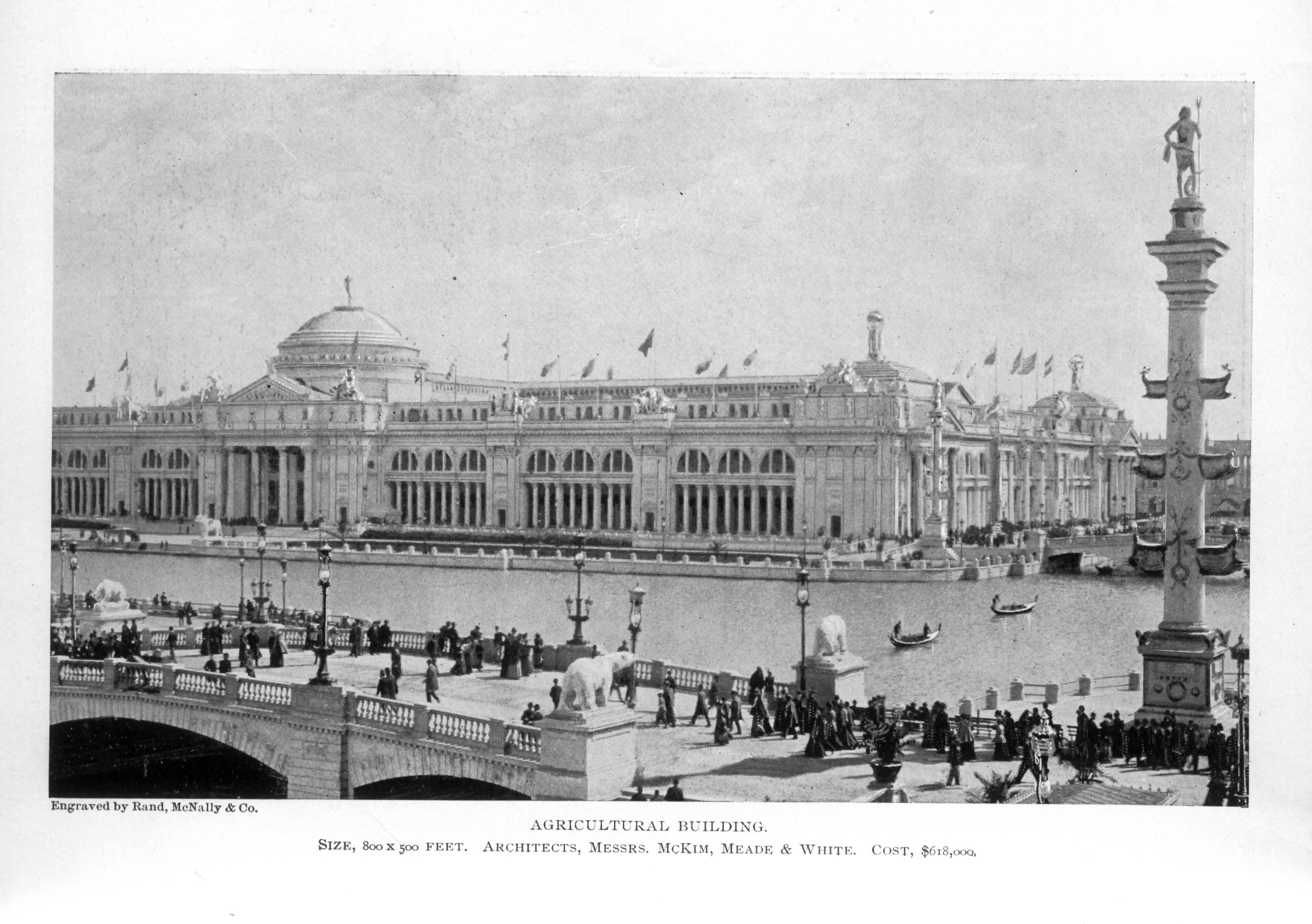
Engraved by Rand, McNally & Co.
AGRICULTURAL BUILDING.
SIZE, 800 X 500 FEET. ARCHITECTURE, MESSRS. MCKIM, MEADE, & WHITE. COST, $618,000.
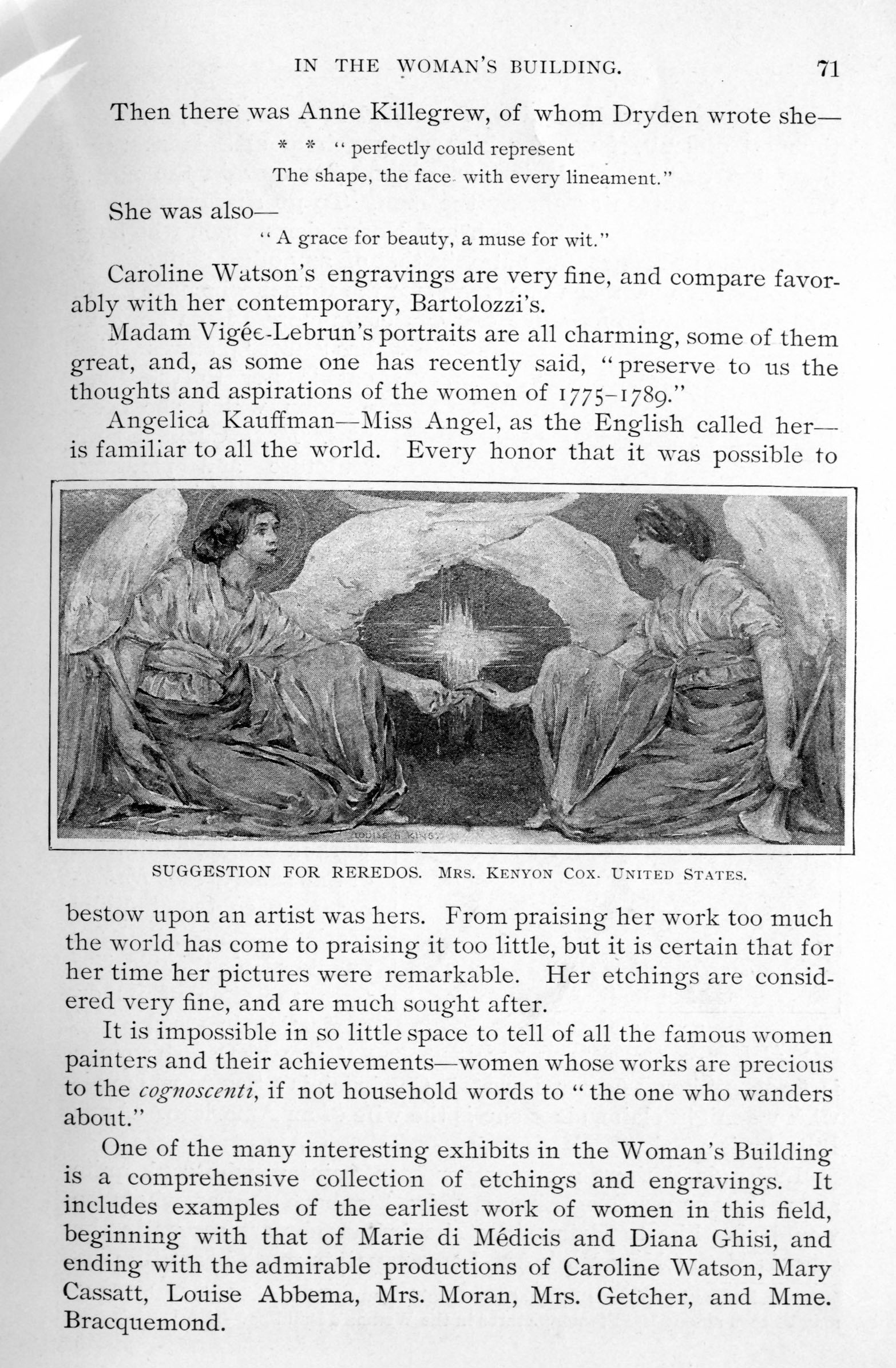
SUGGESTION FOR REREDOS.
MRS. KENYON COX.
UNITED STATES.
Then there was Anne Killegrew, of whom Dryden wrote she—
* * "perfectly could represent
The shape, the face with every lineament."
She was also—
"A grace for beauty, a muse for wit."
Caroline Watson's engravings are very fine, and compare favorably with her contemporary, Bartolozzi's.
Madam Vigée-Lebrun's portraits are all charming, some of them great, and, as some one has recently said, "preserve to us the thoughts and aspirations of the women of 1775-1789."
Angelica Kauffman—Miss Angel, as the English called her—is familiar to all the world. Every honor that it was possible to bestow upon an artist was hers. From praising her work too much the world has come to praising it too little, but it is certain that for her time her pictures were remarkable. Her etchings are considered very fine, and are much sought after.
It is impossible in so little space to tell of all the famous women painters and their achievements—women whose works are precious to the cognoscenti, if not household words to "the one who wanders about."
One of the many interesting exhibits in the Woman's Building is a comprehensive collection of etchings and engravings. It includes examples of the earliest work of women in this field, beginning with that of Marie di Médicis and Diana Ghisi, and ending with the admirable productions of Caroline Watson, Mary Cassatt, Louise Abbema, Mrs. Moran, Mrs. Getcher, and Mme. Bracquemond.
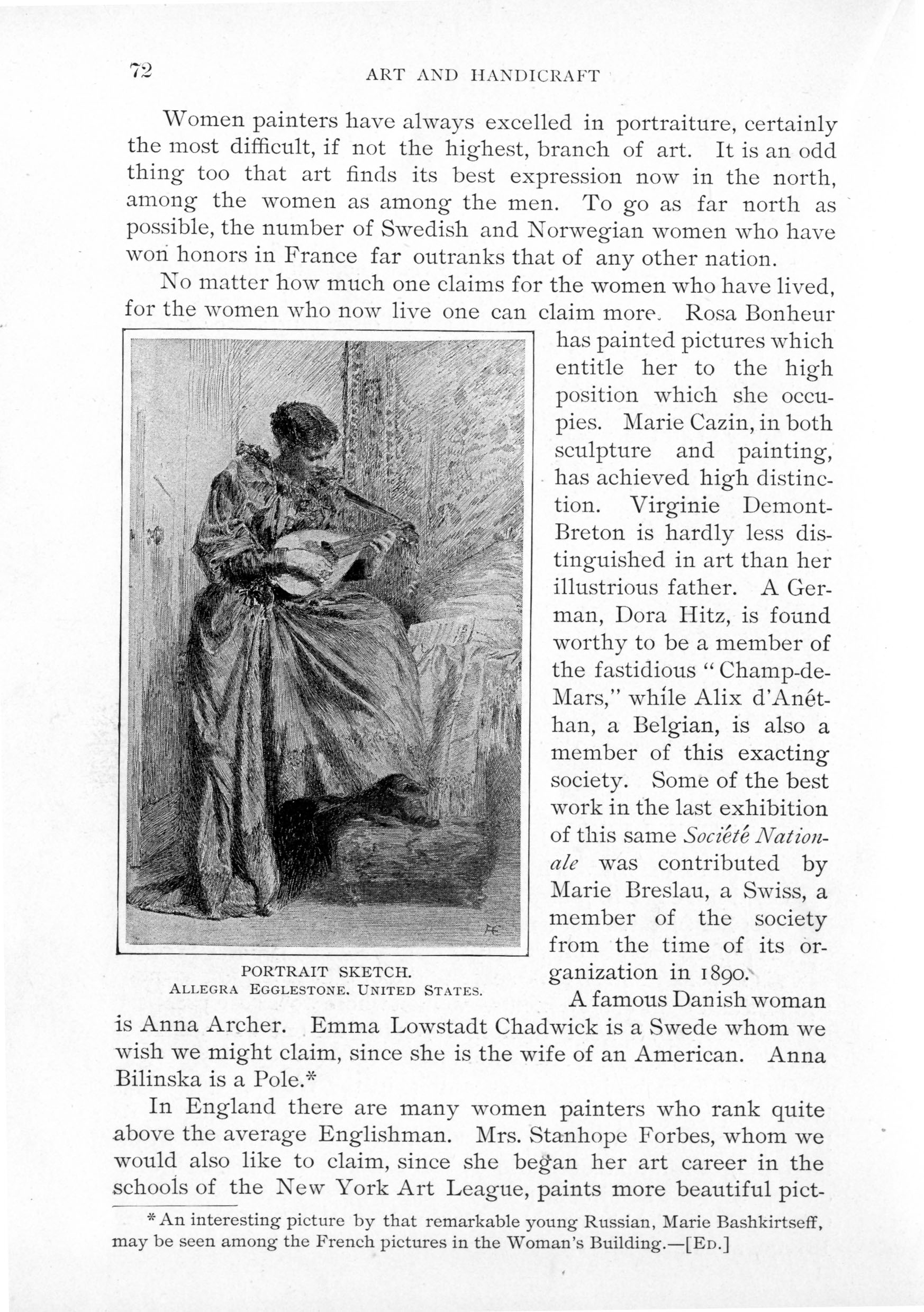
PORTRAIT SKETCH.
ALLEGRA EGGLESTONE.
UNITED STATES.
Women painters have always excelled in portraiture, certainly the most difficult, if not the highest, branch of art. It is an odd thing too that art finds its best expression now in the north, among the women as among the men. To go as far north as possible, the number of Swedish and Norwegian women who have won honors in France far outranks that of any other nation.
No matter how much one claims for the women who have lived, for the women who now live one can claim more. Rosa Bonheur has painted pictures which entitle her to the high position which she occupies. Marie Cazin, in both sculpture and painting, has achieved high distinction. Virginie Demont-Breton is hardly less distinguished in art than her illustrious father. A German, Dora Hitz, is found worthy to be a member of the fastidious "Champ-de-Mars," while Alix d'Anéthan, a Belgian, is also a member of this exacting society. Some of the best work in the last exhibition of this same Société Nationale was contributed by Marie Breslau, a Swiss, a member of the society from the time of its organization in 1890.
A famous Danish woman is Anna Archer. Emma Lowstadt Chadwick is a Swede whom we wish we might claim, since she is the wife of an American. Anna Bilinska is a Pole.*
In England there are many women painters who rank quite above the average Englishman. Mrs. Stanhope Forbes, whom we would also like to claim, since she began her art career in the schools of the New York Art League, paints more beautiful pic-
* An interesting picture by that remarkable young Russian, Marie Bashkirtseff, may be seen among the French pictures in the Woman's Building.—[ED.]
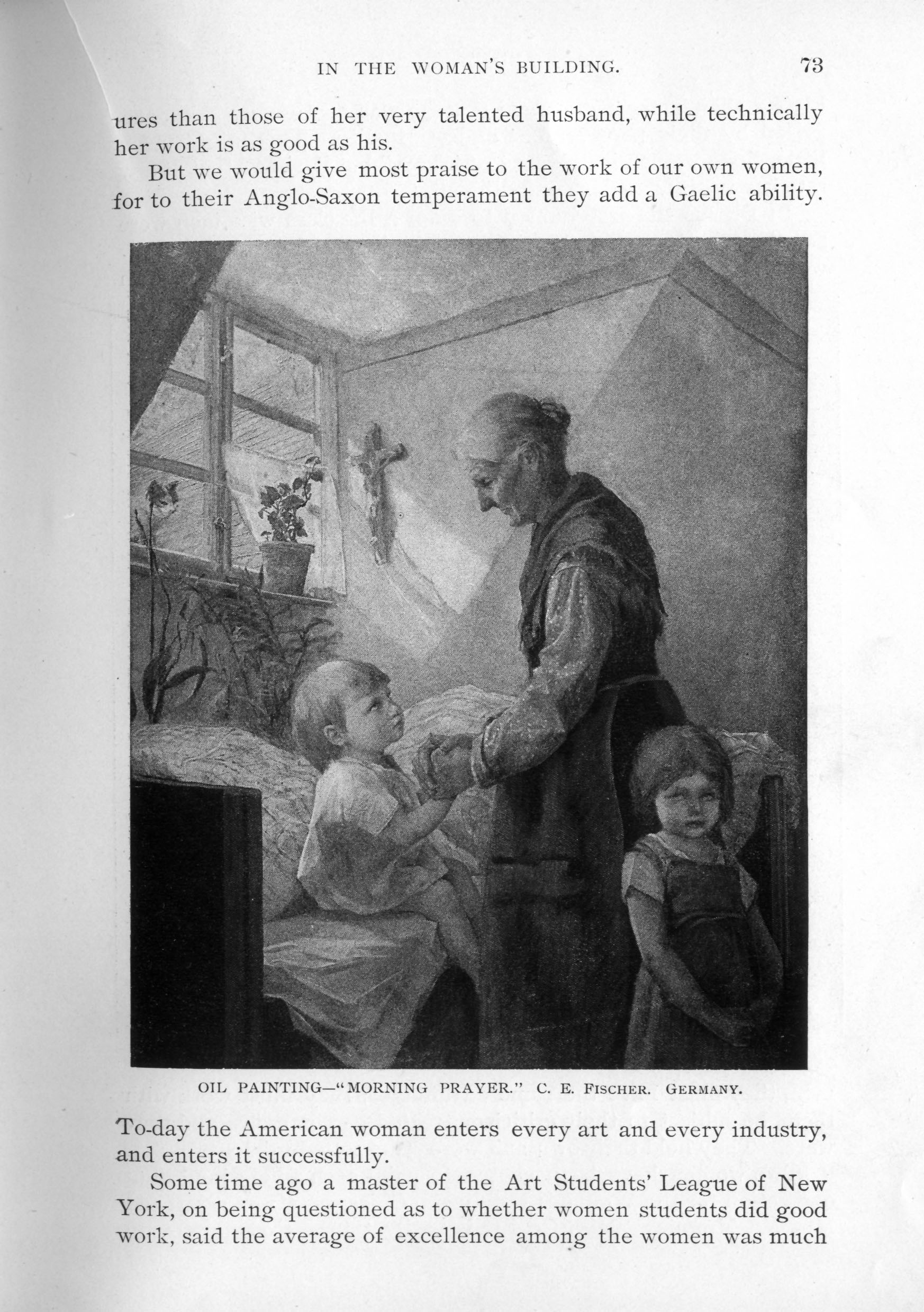
OIL PAINTING—"MORNING PRAYER."
C. E. FISCHER. GERMANY.
tures than those of her very talented husband, while technically her work is as good as his.
But we would give most praise to the work of our own women, for to their Anglo-Saxon temperament they add a Gaelic ability. To-day the American woman enters every art and every industry, and enters it successfully.
Some time ago a master of the Art Students' League of New York, on being questioned as to whether women students did good work, said the average of excellence among the women was much
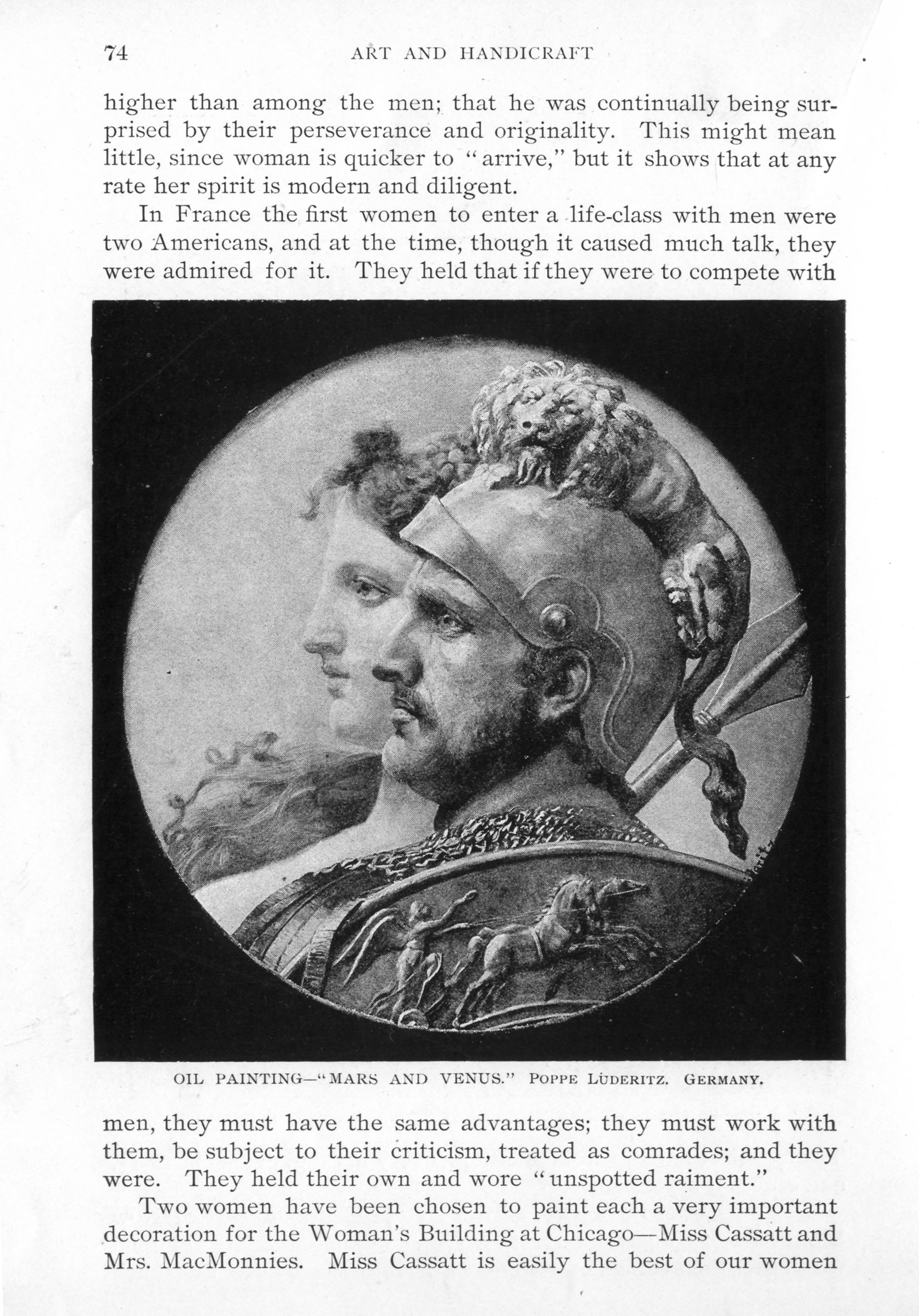
OIL PAINTING—"MARS AND VENUS."
POPPE LUDERITZ.
GERMANY.
higher than among the men; that he was continually being surprised by their perseverance and originality. This might mean little, since woman is quicker to "arrive," but it shows that at any rate her spirit is modern and diligent.
In France the first women to enter a life-class with men were two Americans, and at the time, though it caused much talk, they were admired for it. They held that if they were to compete with men, they must have the same advantages; they must work with them, be subject to their criticism, treated as comrades; and they were. They held their own and wore "unspotted raiment."
Two women have been chosen to paint each a very important decoration for the Woman's Building at Chicago—Miss Cassatt and Mrs. MacMonnies. Miss Cassatt is easily the best of our women
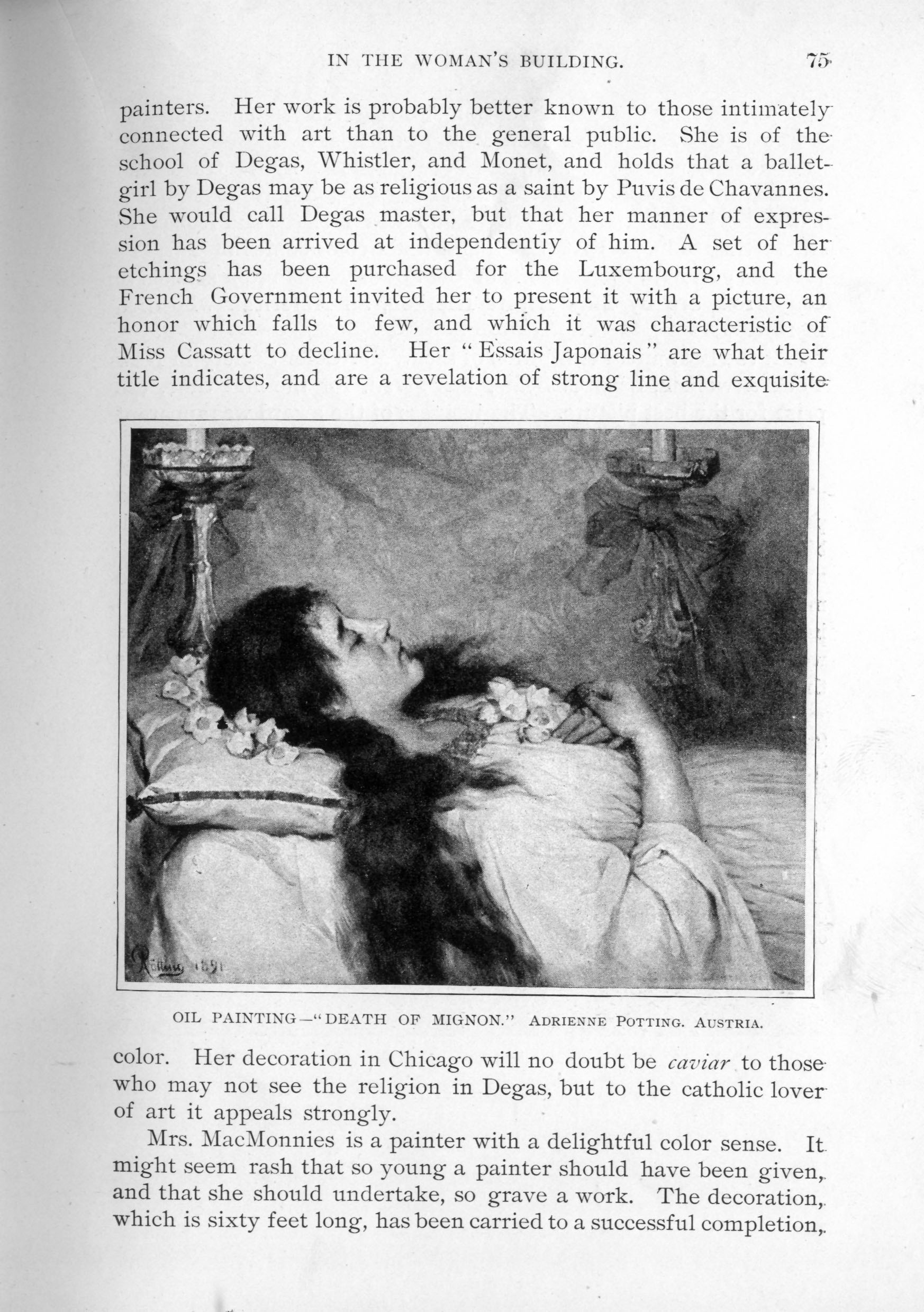
OIL PAINTING—"DEATH OF MIGNON."
ADRIENNE POTTING.
AUSTRIA.
painters. Her work is probably better known to those intimately connected with art than to the general public. She is of the school of Degas, Whistler, and Monet, and holds that a ballet-girl by Degas may be as religious as a saint by Puvis de Chavannes. She would call Degas master, but that her manner of expression has been arrived at independently of him. A set of her etchings has been purchased for the Luxembourg, and the French Government invited her to present it with a picture, an honor which falls to few, and which it was characteristic of Miss Cassatt to decline. Her "Essais Japonais" are what their title indicates, and are a revelation of strong line and exquisite color. Her decoration in Chicago will no doubt be caviar to those who may not see the religion in Degas, but to the catholic lover of art it appeals strongly.
Mrs. MacMonnies is a painter with a delightful color sense. It might seem rash that so young a painter should have been given, and that she should undertake, so grave a work. The decoration, which is sixty feet long, has been carried to a successful completion,
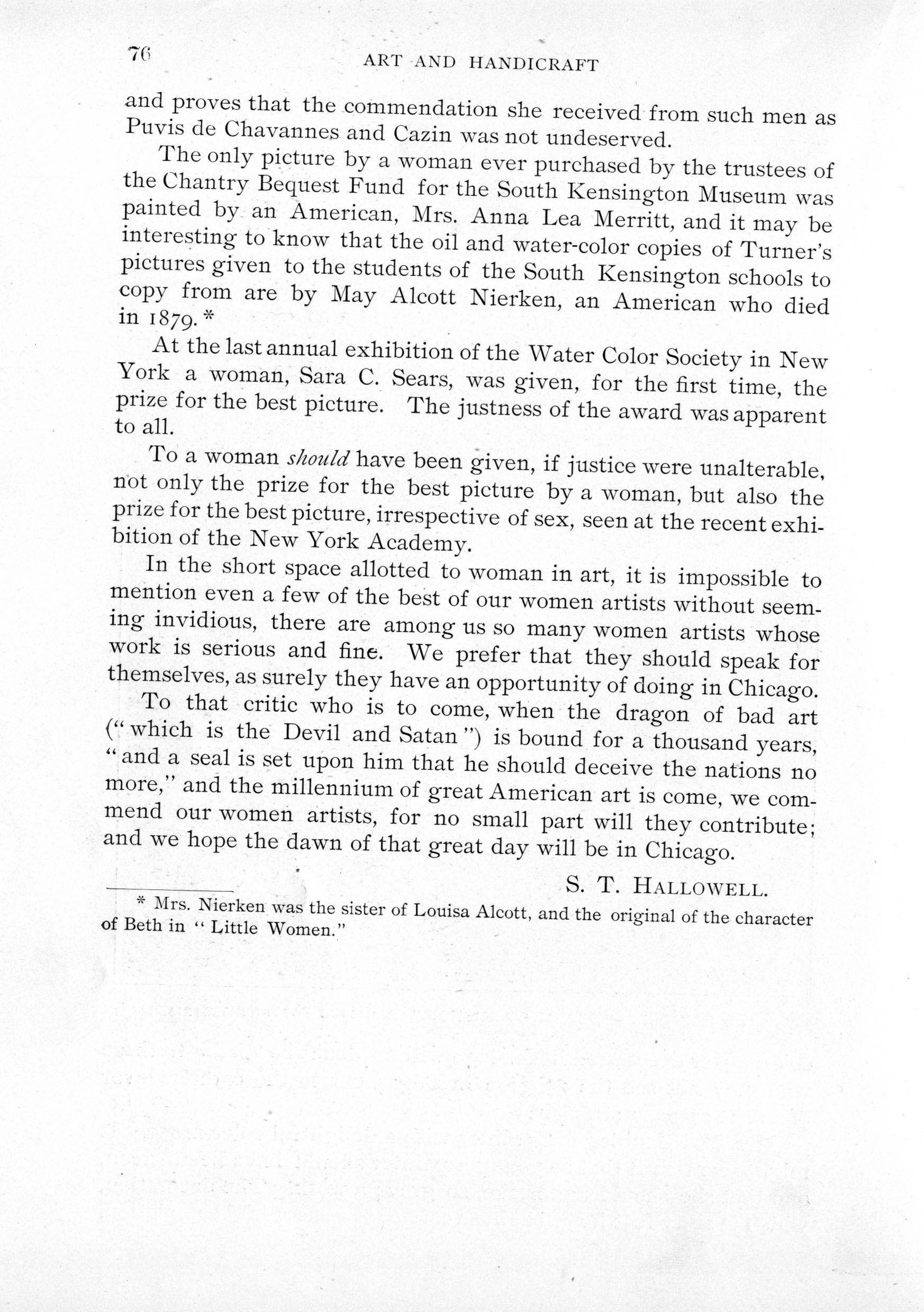
and proves that the commendation she received from such men as Puvis de Chavannes and Cazin was not undeserved.
The only picture by a woman ever purchased by the trustees of the Chantry Bequest Fund for the South Kensington Museum was painted by an American, Mrs. Anna Lea Merritt, and it may be interesting to know that the oil and water-color copies of Turner's pictures given to the students of the South Kensington schools to copy from are by May Alcott Nierken, an American who died in 1879.*
At the last annual exhibition of the Water Color Society in New York a woman, Sara C. Sears, was given, for the first time, the prize for the best picture. The justness of the award was apparent to all.
To a woman should have been given, if justice were unalterable, not only the prize for the best picture by a woman, but also the prize for the best picture, irrespective of sex, seen at the recent exhibition of the New York Academy.
In the short space allotted to woman in art, it is impossible to mention even a few of the best of our women artists without seeming invidious, there are among us so many women artists whose work is serious and fine. We prefer that they should speak for themselves, as surely they have an opportunity of doing in Chicago.
To that critic who is to come, when the dragon of bad art ("which is the Devil and Satan") is bound for a thousand years, "and a seal is set upon him that he should deceive the nations no more," and the millennium of great American art is come, we commend our women artists, for no small part will they contribute; and we hope the dawn of that great day will be in Chicago.
S. T. HALLOWELL.
* Mrs. Nierken was the sister of Louisa Alcott, and the original of the character of Beth in "Little Women."
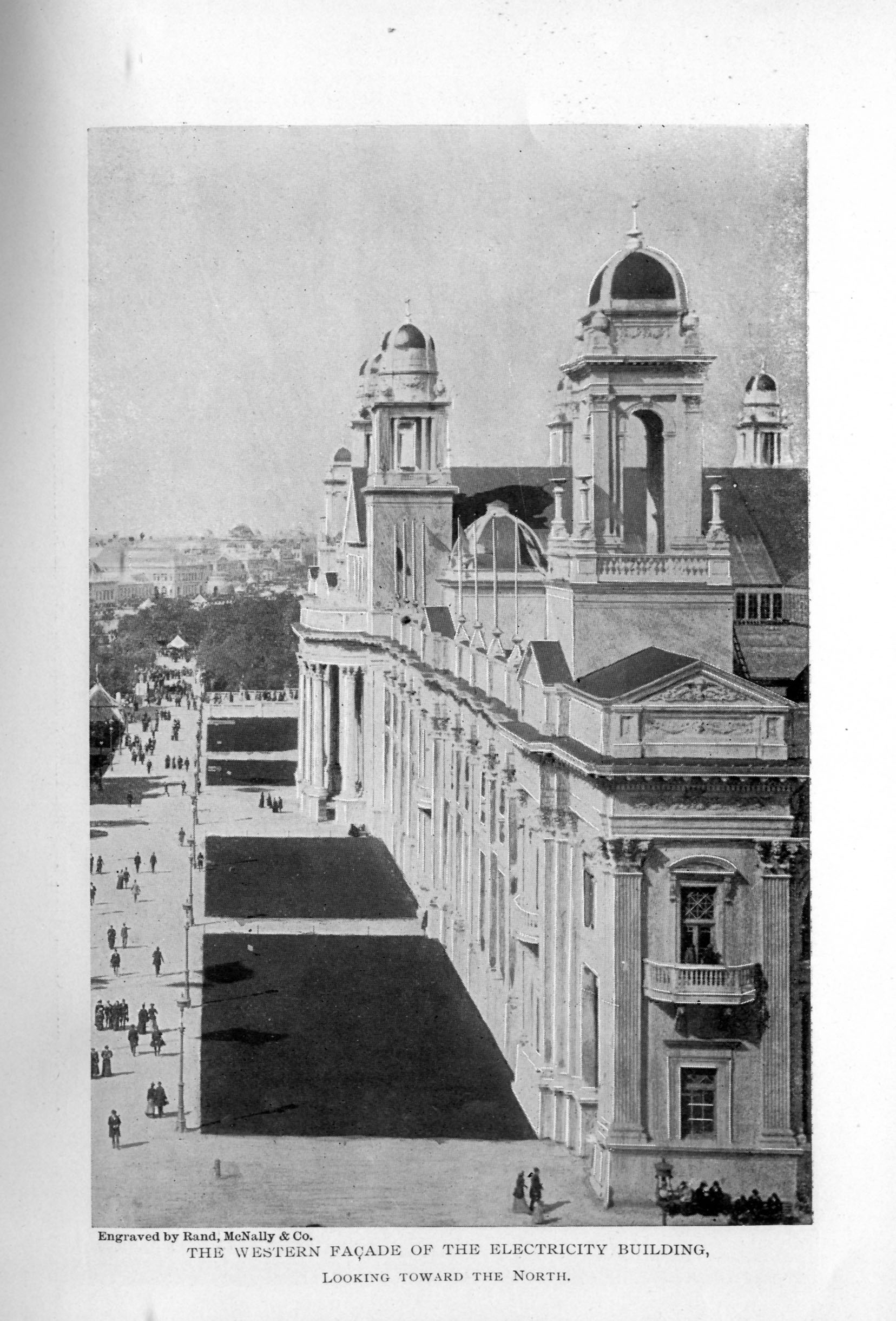
Engraved by Rand, McNally & Co.
THE WESTERN FAÇADE OF THE ELECTRICITY BUILDING,
LOOKING TOWARD THE NORTH.
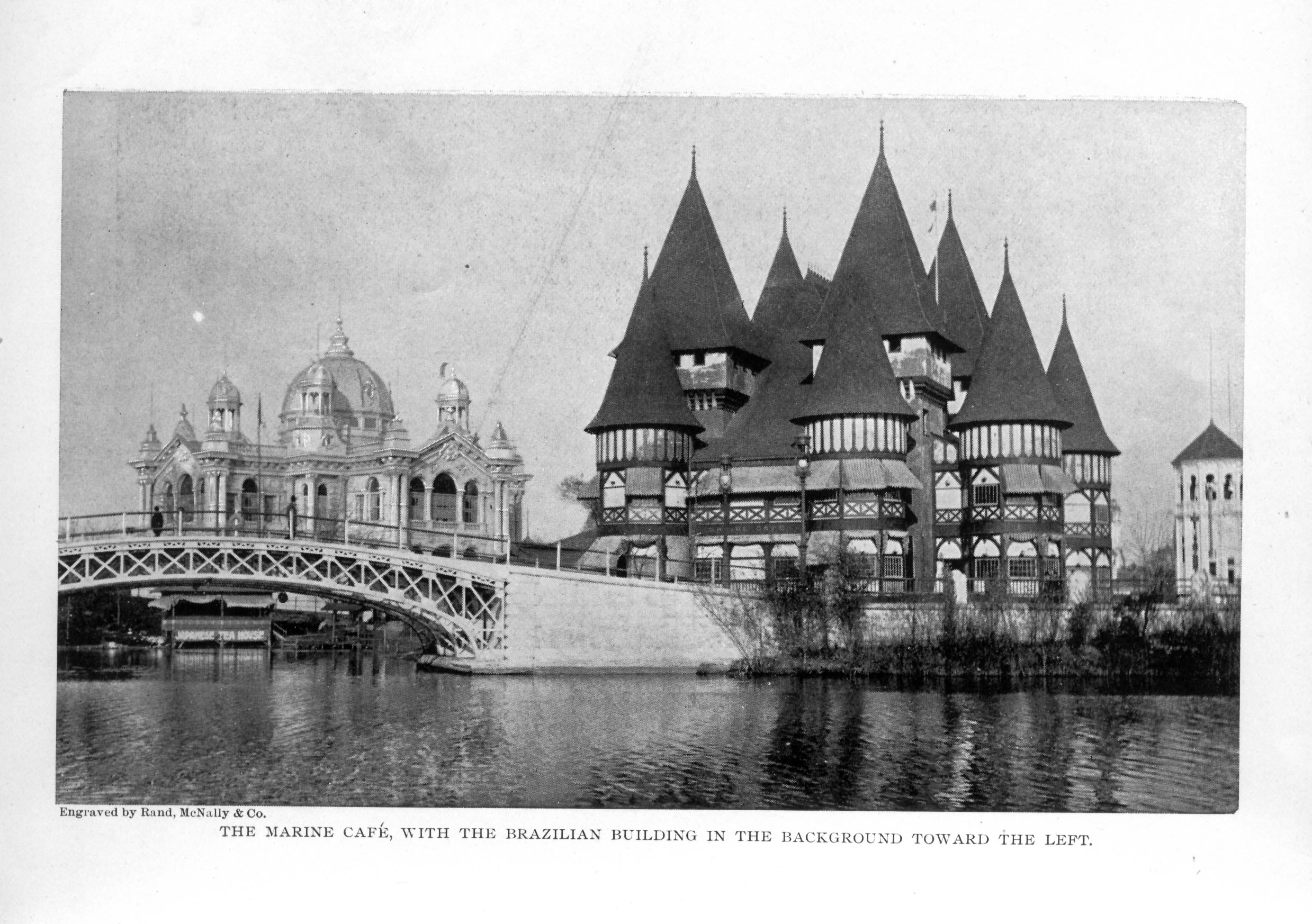
Engraved by Rand, McNally & Co.
THE MARINE CAFÉ, WITH THE BRAZILIAN BUILDING IN THE BACKGROUND TOWARD THE LEFT.